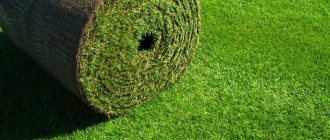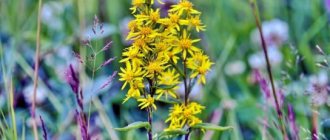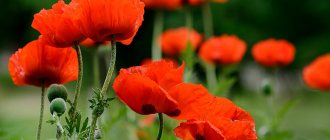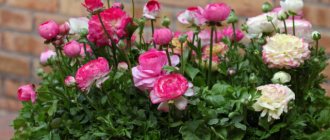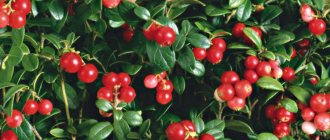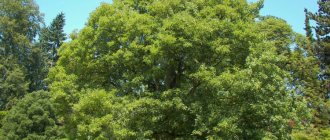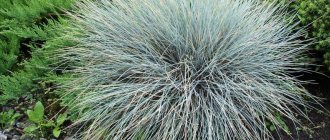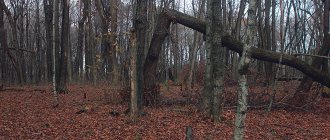What happens
In trade, seed material for growing lawns is presented in the form of a mixture of grasses. It is selected taking into account the purpose of using the lawn. The mixture contains herbs with the characteristics necessary for further use. In some cases, monograsses are used to grow lawns.
In total, there are 7 types of herbs used for these purposes:
- Tall lawn grasses (narrow ironweed, creeping wheatgrass, awnless bromegrass, vicoleaf sainfoin). The height of these herbs can reach more than 1 m. This group of plants is distinguished by its tallness, light-loving nature and thick stems. The advantages of grasses of this type include rapid growth, but the disadvantage is the need for frequent mowing. The grass has to be mowed several times a month.
- Semi-upland lawn grasses (yellow alfalfa, meadow timothy, perennial ryegrass). The group includes medium-sized lawn grasses. Their stems are 50-100 cm high. After cutting, the grasses very quickly come to life and grow, creating a dense lawn carpet. This type of plant is used for seeding large lawns. Herbs combine harmoniously with garden flowers.
- Medium-sized lawn grasses (red fescue, meadow bluegrass, bentgrass). The height of the plants included in the group can reach 50-70 cm. They are distinguished by thin stems and strong bushiness. The advantage of herbs of this type is their ease of care.
- Low-growing lawn grasses (white clover, periwinkle, thyme). Plants belonging to this group are used to create dense, low-growing grass carpets. They are characterized by slow growth. Despite this, lawns made from these grasses require frequent mowing. They also need regular watering. Herbs from this group are used to create lawns only in a mixture. To create a dense canvas, grass is cut to a height of 4-5 cm. The main disadvantage of plants is the high cost of seed.
- Rhizomatous lawn grasses (white bentgrass, bluegrass, meadow foxtail). A feature of plants of this type is the rapid growth of roots, which contributes to the formation of many new shoots. The grass carpets made from them are distinguished by their density, which is preserved for many years.
- Loose-bush lawn grasses (meadow fescue, wild grass, rhizomatous wheatgrass). This group of plants includes grasses with a shallow root system. They differ in that they have only one tillering node. Due to the spreading nature of the grass bushes, their lawns have good density.
- Tap-root lawn grasses (horned grass, blue alfalfa, red clover). The plants have lush bushes, are easy to care for, and look beautiful in a single carpet of lawns.
Primary requirements
Not every grain is suitable for creating a lawn. To get into the finished grass mixture, lawn grass seeds must meet a number of requirements:
The first criterion is the decorativeness and aesthetics of the grass. It should be soft, retain its natural color for a long time, without fading from the sun.
To operate in low temperature conditions, varieties must be frost-resistant.
The ability to form a good root system is very important. A branched underground part is a necessary condition for plant growth in all types of soil.
The selected species should be easily restored after cutting, mulching and other procedures.
From a maintenance point of view, it is better to use perennial grass seeds. They do not have to be sown annually; it is enough to reseed them in small areas.
The final choice is made based on the purpose of the coating, climatic conditions, lighting and soil type.
Be sure to pay attention to the expiration date of the seeds.
Advantages over wild
Plants intended for creating lawns are characterized by rapid growth of shoots. This allows you to green up your lawn in a few weeks. The seedlings of such grasses form a dense turf layer with an attractive aesthetic layer. Contact with lawn grass causes a pleasant tactile sensation. They have a velvety surface and a rich, rich color.
Lawn grasses have the following advantages:
- take root quickly;
- have a high degree of resistance to various types of plant diseases;
- suppress weed growth;
- have lush bushes with rich colors.
Artificial grass
What to do if there is little light on the site and poor conditions for the growth of natural lawn? The solution would be to install artificial turf. Modern technologies make the visual difference between them almost indistinguishable. It is appropriate to lay such a lawn near the pool and on playgrounds for children.
The product is sold in rolls, which greatly simplifies the installation process. The basis is an elastic backing with a latex layer. A pile 6-10 cm high is attached to it, its density is determined by the purpose of the lawn. Depending on the backfill, there are 3 types of artificial material:
Non-backfill (analogous to a carpet). It is characterized by a small (4-10 mm) fiber height. It is used for landscape design of places where there is no traffic (cafe areas, private courtyards).
Half-filled. It consists of polyethylene threads woven into a rubber base. When laying the lawn, it is covered with quartz sand. This is the best solution for tennis courts and sports complexes. The coating softens falls and promotes a clear rebound of the ball.
Backfill. This is a specific grass used on professional football fields. Backfill is a combination of crumb rubber and sand. The coating has good springiness and reliably protects against injury.
The advantages of artificial lawns are year-round use, wear resistance, hygroscopicity, lack of watering and fertilizing. To remove moisture, drainage holes are provided in the substrate.
Types of herbal mixtures
There are several classifications of grass mixtures. Most often they are divided into:
- fast-growing (have strong tillering of grass mixtures, ensures good density of the lawn and rapid recovery of bald spots);
- solar (grass mixtures have a high degree of resistance to drying and fading under the influence of bright sun and high temperatures);
- shady (intended for planting in shaded areas);
- universal (grass mixtures that are undemanding to location and growing conditions).
Unlike wild grasses and some monocultures, grass mixtures are collected from plant seeds characterized by good germination. Herbs in mixtures are selected taking into account their advantages and disadvantages. The recipe for each lawn mixture is carefully worked out. They are also distinguished by purpose and growing conditions.
How to sow a lawn at the dacha
When planting a grass mixture for a lawn at any time of the year, you must follow the steps of the work. There are many options for preparing a site for a lawn. Let's consider one of them, taking into account that the place is level:
- Before sowing, remove debris from the site, uproot stumps and remove weed roots.
- If the soil on the site leaves much to be desired, then do this. The soil freed from weeds is rolled or compacted. Add leaf compost, mineral fertilizers, and good nutritious soil. The mixture is mixed with a rake and then the seeds are sown.
- If the area has fertile soil, then simply dig it up to the depth of a spade bayonet, breaking up large lumps and leveling it with a rake.
- Calculate the seed rate for the lawn and measure the required amount of seed.
- The entire area for the lawn is divided into small squares/rectangles.
- The mass of seeds is also divided according to the number of plots into equal parts.
- Sow each square with one portion of seeds, scattering them evenly. You need to move from the sown part in the direction of the not yet sown square.
- Then they go through the rake again and irrigate.
The best varieties for the Russian climate
You can create the perfect lawn on your site only by choosing the right seed. The rating of lawn grasses, which is compiled based on expert opinion, can help in choosing it.
Meadow bluegrass
A lawn variety of perennial plant that, with proper care, can create a dense grass cover. Not a single weed grows through it. Meadow grass is the most popular lawn grass.
It can be used for sowing, as a monoculture and as part of grass mixtures. The plant never bushes. Lawns grown from it have a flat surface without plant hummocks.
Advantages:
- rapid growth and greening;
- high degree of resistance to freezing and drought;
- perenniality;
- germination up to 90%.
The disadvantage of the plant is that it requires regular weeding during the first year of growing a lawn. The turf reaches the density necessary to suppress weeds only in the second year.
Irina (agronomist). Advice:
Small meadow bluegrass seeds should be sown in the soil to a depth of no more than 1 cm. The biological feature of the variety is its ability to produce 110-120 shoots per square meter. decimeter, regardless of the planting density of the seed. This means that seed can be sown in soil with low density.
Perennial ryegrass
This variety is often used for sowing on pastures. This gave the plant a second name - perennial ryegrass. The variety is included in many lawn grass mixtures. Its content in them can be up to 25%.
Advantages:
- rapid restoration of vegetation after mowing;
- color stability from early spring to late autumn;
- not afraid of trampling;
- activity and friendliness of seedlings;
- durability (plant lifespan up to 7 years).
Flaws:
- prone to freezing;
- can only be grown in warm regions.
Marina (landscape designer). Advice:
The area for sowing perennial ryegrass should not be flooded in the spring. This will lead to the death of the plantings. Grass can be sown in the ground only when the risk of return frosts has passed.
Red fescue
The variety is ideal for lazy lawn owners. It is easy to care for, has a beautiful silky turf structure, and causes pleasant tactile sensations when in contact with the human body.
The ideal grass mixture for lawns is a mixture of red fescue and bluegrass. A lawn sown with it retains its green cover for a long time, regardless of weather conditions.
Advantages:
- versatility;
- resistance to drought and trampling;
- dense turf cover.
The main disadvantage of fescue can be considered its ability to grow strongly and colonize areas adjacent to the lawn.
Irina (agronomist). Advice:
The best times to sow fescue are spring and autumn. The air temperature during grass planting should not fall below +12°C.
Clover
One of the best types of grass for sowing large areas. The second name of the variety is trefoil. Its bushes have a beautiful emerald color. There are more than 300 types of clover in nature, but only 7 of them are used in landscape design. These include meadow clover, as well as white and red.
Advantages:
- low maintenance;
- high degree of resistance to trampling and various types of plant diseases;
- rapid restoration of the cover after mowing.
Flaws:
- after mowing for several days, clover loses its decorative appeal;
- the smell of the plant attracts insects;
- After rain, the surface of the clover lawn becomes very slippery and does not dry out for a long time.
Clover begins to suppress weeds only from the second year of its life.
Andrey (landscape designer). Advice:
When creating a lawn, it is important to monitor its boundaries. Clover very quickly disperses throughout the area, colonizing neighboring areas.
Polevitsa
The grass is a dark, rich color that can withstand frequent mowing. Most often, bentgrass lawns are arranged around fruit trees in order to avoid contact of falling fruits with the ground.
Advantages:
- undemanding to the composition of the soil;
- versatility;
- quick recovery after mowing;
- ease of care;
- increased turf density;
- high degree of resistance to trampling.
Flaws:
- requires abundant watering during periods of drought;
- in the first year of growth it is not resistant to trampling;
- does not tolerate severe frosts.
Andrey (landscape designer). Advice:
Bentgrass is best suited for seeding sunny areas. Planting seeds in the ground can be carried out from spring to autumn.
Calculation of the amount of seed material
Seeds should be sown in accordance with regulatory recommendations. Otherwise, the lawn will not look as impressive as it should. If there is less seed material than necessary, the lawn covering will turn out to be uneven, in “shreds” and will not create a dense turf. This means that the lawn will have poor resistance to trampling and weeds.
If you sow more seeds than necessary, the plants will suffer from a lack of nutrients and moisture. As a result, diseases will begin to develop.
The seeding rate depends on the characteristics of the soil and the type of grass. On average, 40-50 grams of seeds need to be distributed for every 1 m2 of soil. This parameter is adjusted taking into account the type of soil. For example, on light soils of medium density you will need 30-40 g/m2, but on heavy soils the seed consumption increases to 60 g/m2.
Seeding rates can be seen below:
Lifehacks for sowing
To obtain the same density of turf over the entire area, the seed must be sown crosswise, passing in two directions. In the first pass, half of the seed is sown. You need to scatter it into the ground without any bald spots. The remaining part of the seeds is sown into the soil in the second pass, which is carried out according to the algorithm of the first.
Good adhesion of seeds to the soil can be ensured by spraying it with water from a fine spray nozzle. It is strictly forbidden to water the lawn after sowing with water from a hose without a sprayer.
What kind of lawn would you like to grow on your property?
MonoherbsHerb mixture
Before sowing grass, it is necessary to check the expiration date of the seed. You should not use seeds with a shelf life of more than 2 years for planting a lawn.
You can ensure a higher percentage of grass germination by using covering material or mulching the soil. In the first case, crops are covered with agrofibre if the air temperature during planting is below 15 degrees or there are many birds in the planting area. Mulching the soil is done when planting lawn grass in sandy or peat soil.
When and how to sow seeds correctly?
There are several methods for sowing a lawn area with grass seeds.
- Using a seeder. First, the required amount of seeds is poured into the seeder. To facilitate sowing, the area is marked into squares and seeds are sown in them, taking into account the consumption rate.
- Manual option. Sowing is carried out first along and then across the area allocated for the lawn. In the manual method, seeds are mixed with sand in a ratio of 1:3 and scattered evenly over the prepared soil.
- Using a tin can. A small tin can can replace the seeder. Holes are made in the jar that are slightly larger than the size of the seeds. Sowing is carried out by analogy with the manual method, with the addition of river sand to the seeds and moving along the site lengthwise and crosswise.
Lawn grass is sown at any time during the growing season: from late April to mid-September. It takes approximately 4-5 weeks before the crops take root. These dates must be taken into account when sowing herbs in the fall, so that rooting takes place before the onset of frost.
The optimal time is spring.
Seeds are sown when the average daily temperature is not lower than +12-15 degrees. The gentle rays of the sun will ensure high seed germination and prevent the death of shoots due to heat.
But in the spring, weeds also actively grow - you will have to weed them out on the site, otherwise they will choke the young sprouts of lawn grass.
Sowing grasses for the lawn is very attractive for gardeners, because you can completely clear the area of weeds before sowing the seeds. Work is carried out only early in the morning or when the sun's rays become less aggressive (after 19:00). At this time, it is important to prevent the top layer of earth from drying out.
Sowing in autumn is carried out one and a half to two months before the onset of frost.
Before sowing, the area is cleared of remaining grass and weeds. Be sure to add leaf compost.

